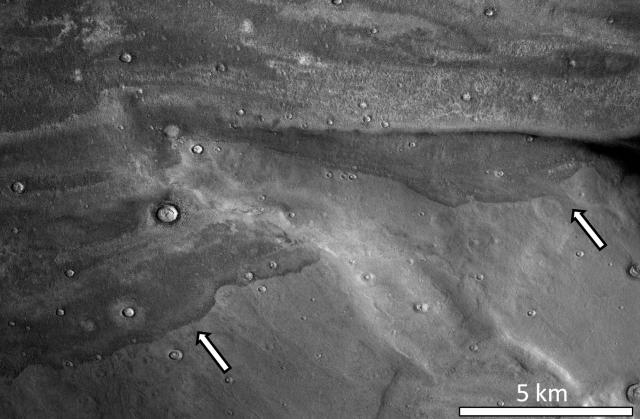
Lots of evidence suggests that Mars once had copious amounts of water. There's even some evidence that the planet may have had a large ocean covering the northern pole of the planet. But the existence of the ocean remains controversial. An ostensible shoreline isn't visible across the entire basin that would have been occupied, and arguments have been made that ice would have covered any significant body of water.
Now, however, a large team of scientists has put forward an idea that may help reconcile a number of the apparent contradictions: giant Martian tsunamis. They suggest that one particular region of the red planet they've looked at contains evidence for two of them, the second of which may have driven an icy slurry across Mars' coastal plains.
If you assume an ocean was once in place on Mars, then a tsunami is probably a predictable event. The authors estimate that, in the region they're looking at (part of the Arabia Terra), a meteor big enough to carve out a 30km wide crater would have hit about once every 15 million years. For the area in question, that translates to 23 of these impacts during the time the ocean was thought to be in place.
Given the weak Martian gravity, the results could have been spectacular: simulations indicate a tsunami 50m tall on average, with local conditions possibly pushing it as high as 120m. That would leave a mark.
And, the team argues, it did. Images of the region show a lot of areas where boulders, often meters in diameter, have accumulated. The lobes of these deposits are shaped such that it appears that whatever left them was flowing uphill at the time. They also flow around prominent landscape features. Elsewhere, a large collection of channels appear to have formed when the water flowed back into the ocean. "These channels have remarkable similarities to terrestrial tsunami backwash channels," the authors argue.
The scary thing is that these features often extend over a few hundred meters of elevation gain. That's in keeping with the simulations of Martian tsunamis, but it's staggering compared to their terrestrial counterparts.

The authors argue that there are indications of two distinct events here, based on the fact that the features end at two different elevations. The earlier one occurred when the shoreline was higher, suggesting a deeper ocean in Mars' more distant past. The more recent one (which is still billions of years old) had a shoreline 300m deeper in the planet's northern basin, suggesting the ocean was in the process of shrinking when it occurred.
It may have also been in the process of freezing as Mars chilled down from its warmer past. Some of the deposits it left behind have lobes that include thick layers of ice. Given that water wouldn't have sat still to freeze after a tsunami, the authors argue that it likely carried significant ice with it, leaving it behind as the watery part retreated. They even suggest that it may have been a wave of ice similar to some that occur on Earth.
This doesn't conclusively show that there was once an ocean on Mars. But the combination of a slowly shrinking ocean and the dramatic resurfacing of of the nearby plains would mean that we shouldn't expect to see evidence of a tidy shoreline. The rate of bombardment Mars suffered during the time the ocean was present would mean that tsunami deposits should be found elsewhere along the ancient ocean basin. So the next step for this model would be to search areas beyond Arabia Terra.
Scientific Reports, 2016. DOI: 10.1038/srep25106 (About DOIs).
reader comments
20